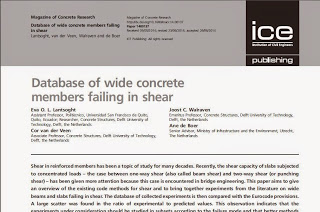Database of wide concrete members failing in shear
It’s with pleasure and pride that I announce today that we have published a paper in the Magazine of Concrete Research. It’s already available ahead of print on the MoCR website.
This paper is based on a part of the second chapter of my dissertation, which focused on compiling a database of experiments on slabs in shear from the literature.
The abstract of the paper is the following:
Shear in reinforced members has been a topic of study for many decades. Recently, the shear capacity of slabs subjected to concentrated loads – the case between one-way shear (also called beam shear) and two-way shear (or punching shear) – has been given more attention because this case is encountered in bridge engineering. This paper aims to give an overview of the existing code methods for shear and to bring together experiments from the literature on wide beams and slabs failing in shear. The database of collected experiments is then compared with the Eurocode provisions. A large scatter was found in the ratio of experimental to predicted values. This observation indicates that the experiments under consideration should be studied in subsets according to the failure mode and that better methods for determining the shear capacity of wide concrete members are necessary. The database also shows the need for experiments aimed at studying shear in one-way slabs and the effect of different parameters on the shear capacity.
Did you notice how quickly this paper went through? Look into the header of the paper, and you see that I submitted it on May 5th 2014, it was revised on June 23rd and then accepted on June 26th. I’ve never had a journal paper breezing through so easily…

